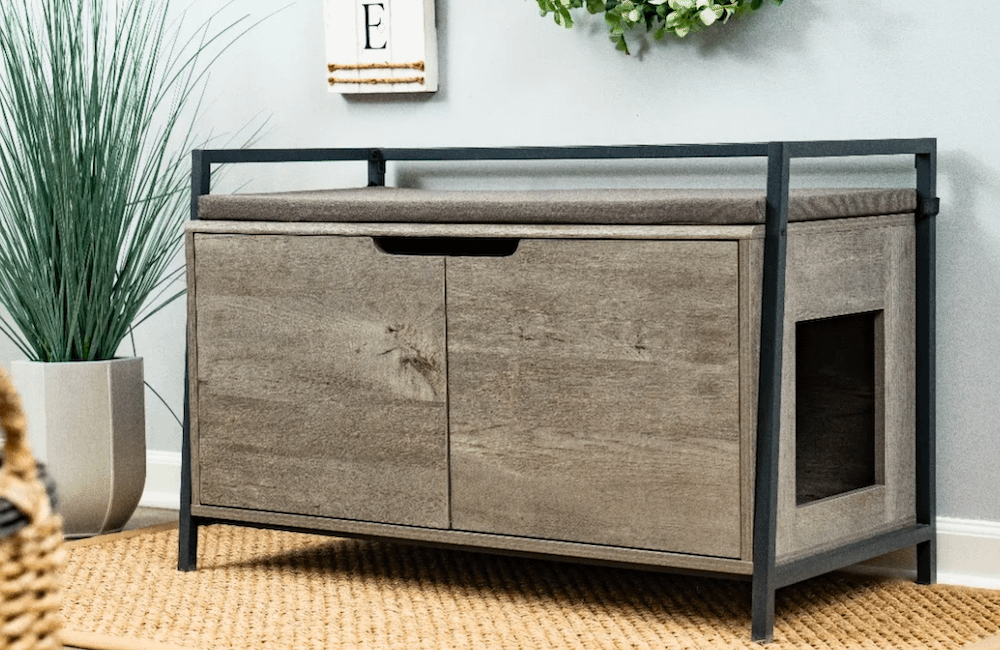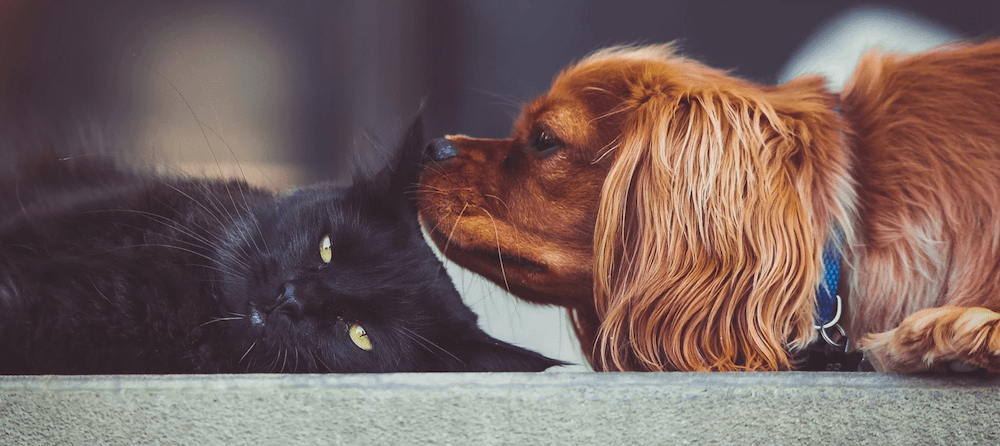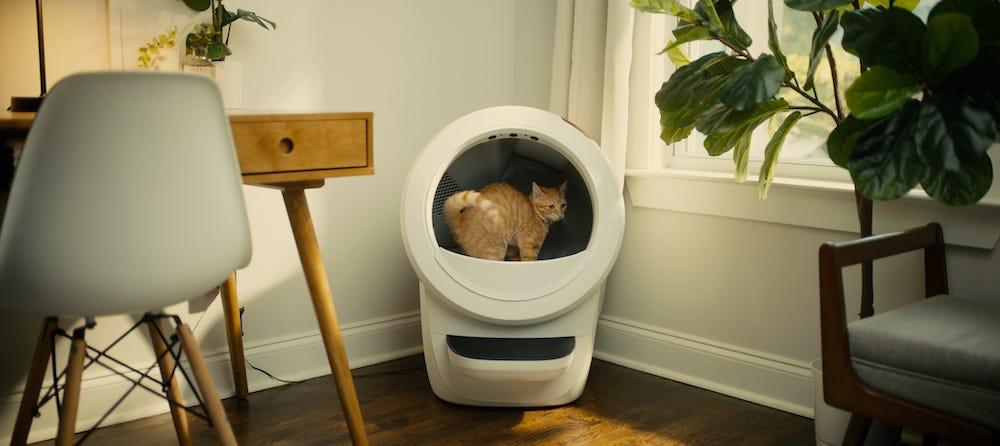Being a pet parent to both canines and felines (that's tens of millions of people in the U.S.) can come with a few challenges, the first of which is simply introducing cats and dogs.
Another ongoing struggle? Keeping the dog out of the cat litter box. The reality is, dogs eat cat poop. Yuck. Fortunately, there are many solutions out there, but the trick is to stay consistent. If you're one of the many people having this problem, try these tips to dog-proof the cat litter box.
Why dogs eat cat poop
Dogs eating cat poop, while unpleasant for their owners, is a surprisingly common behavior that has several explanations rooted in canine instincts and biology:
- Protein and fat content: Cat food is typically higher in protein and fat than dog food. As a result, undigested nutrients may remain in cat feces, making it enticing to dogs.
- Instinct: Dogs are natural scavengers. Their ancestors survived by eating whatever they could find, including waste, which might explain their interest in cat poop.
- Curiosity: Dogs are naturally curious animals. They explore their environment using their noses and mouths, and the strong scent of cat feces might draw their attention.
- Boredom or anxiety: Dogs left alone for extended periods or lacking stimulation may engage in undesirable behaviors like eating cat poop to entertain themselves or relieve stress.
- Medical issues: Health problems like intestinal parasites, nutritional deficiencies, or diseases that cause increased hunger can drive dogs to seek out unusual food sources.
How to keep dogs out of the litter box
1. Scoop regularly
If you’re looking for other tricks without spending extra money, the first thing you can do is scoop the litter box immediately after your cat is finished with their business. If the litter box is clean, there will be no poop for the dog to sniff out.
2. Set up physical barriers
Cats can slip into places dogs can't and jump over high barriers with ease. To dog-proof the cat litter box means starting as simple as cutting off access to the area or room where you keep the litter box.
- Put a baby gate around the litter box. Even better, choose a baby gate with a built-in pet door.
- Install a door latch (or a door chain) that lets the door open just enough for your cat to enter, but not your dog (or toddlers for that matter).
- Install a cat door in the door of the room where you keep the litter box to let your cat enter, but keep your dog out. (Now you just have to remember to close the door.)
3. Change the litter box design
It may take your cats some getting used to, but once they realize the dog won't invade their litter box, they'll confidently adopt a new litter box.
- Switch to a covered litter box instead of the traditional open litter box tray or pan. Or, select one with an indirect or top entryway, so that kitty can enter, but doggy cannot.
- Place the litter box in a cabinet or other piece of litter box furniture, so that the oh-so-enticing scent (ew) of the kitty waste is contained and dog entry is restricted.
- Consider self-cleaning litter boxes to automatically dispose of waste into a sealed compartment, reducing odor and dog access.
“I keep my litter box in a credenza in a corner with the open side about 6 inches away from the wall so that my dogs cannot get to their favorite kitty poop snack.” - Laria Herod, DVM

4. Remove the temptation
Try to get rid of the waste as soon as it happens.
- Clean the litter box twice a day. The most direct way to dog-proof the cat litter box is to remove the temptation, which means scooping often. If you feed your cats at the same times each day, chances are they use the litter box at predictable times. Get to know your cats' patterns and try to remove waste as soon as you can.
- Switch to a self-cleaning litter box. If scooping within minutes of your cat using the litter box seems too demanding, opt for an automatic, self-cleaning litter box that does the work for you. For example, after your cat uses Litter-Robot, it automatically cycles the waste into a fully enclosed drawer, making the waste unavailable to the dog.
5. Train
Instead of modifying your home or schedule, break your dog's habit of seeking "treats" from the litter box with training (and getting real treats from you instead).
- Allow the dog access to the litter box (that is, don't barricade it), and be present.
- When your dog goes for the litter box, give the "leave it" command.
- Have your dog come to you and be ready with a treat.
- Offer praise, then relax and wait for your dog to think about the litter box again. Each time your dog goes for the litter box, give the leave it command and offer a treat.
- Be consistent and praise your pet generously.
When you are not around, it may be a good idea to barricade the litter box and work up to leaving it out in the open.
6. Make it less appetizing
This strategy isn't just about removing the temptation; it's trying to permanently eliminate it.
- Use cat supplements. There are supplements you can add to your cat's food to make the poop less desirable to your dog, but that only works if your cat is amenable to a diet change. Talk to your veterinarian before trying this tactic.
- Spray deterrent on the litter box. To make the waste less appetizing to your dog, try spraying a chewing deterrent spray like bitter apple or apple cider vinegar on the clumps. When your dog goes for a "treat," it will taste awful, and teach your dog that those clumps just aren't that tasty. A word of caution: the smell of the deterrent spray may also deter your cat from using the litter box.
Depending on the size of your dog (and number of them), different strategies or combinations will work best for your furry family. Whatever strategy you choose, stay consistent and stay positive. Most things fail when we stop trying, not because they won't work. After all, giving your cat a more private place to go (where the dog doesn't trespass) is also a good way to ensure healthy litter box habits. Bonus: you can stop avoiding those eager dog kisses.
For more litter box tips, read our full litter box guide.

What makes a good dog-proof litter box?
While keeping your dog out might be your main priority for your new dog-proof litter box, you should consider keeping your cat happy as well. Finding a good dog-proof litter box that is cat-approved will make your life as a pet parent much easier. Consider looking for litter boxes that have the following features.
Cats enter from the top
A top-entry litter box is a great solution. Instead of your cat entering from the front (or an open top box), they enter from the top. It is a great way to keep smaller dogs out of the litter box, and even larger dogs will have a harder time searching for a “snack.”
This litter box style works well for healthy, agile cats but tends to be problematic for older, overweight, or arthritic kitties. If your cat falls into one of those categories, be mindful of this before committing to this style.
Self-cleaning functionality
A self-cleaning litter box will not only keep your pup out of the cat’s poop, it also saves you time and helps reduce odors. After your cat makes his deposit, the self-cleaning function goes to work to remove any remnants into a hidden compartment. The poop is hidden from the dog, and you are back to welcoming all their slobbery kisses.
Be aware that some dog siblings are stalkers and will wait for the cat to poop to get the poop snack as fresh as possible; if your dog falls into this category, the self-cleaning function may need to be paired with some additional environmental engineering to be 100% effective. Strategic organization or furniture often gets the job done.
Comes with a door or cover
A litter box with a door or cover will slow down any sneaky pooch! The cat can get into the box, but the door will deter or slow down larger dogs.
Great design aesthetics
Let’s face it—not all litter boxes are created equal. And just because you have pets does not mean everyone who visits wants to see an open box. A good litter box design will provide your cat with plenty of space to move around comfortably, while keeping your dog out of their business.
Works with litter box furniture
You can also consider using litter box furniture to hide the box, adding one extra preventative layer to keep your dog out. Be sure to choose a piece that provides your cat with easy access to their bathroom and (bonus) looks stylish in your home.
The best dog-proof litter box
Now that you know what to look for, we have provided our recommendation for the best dog-proof litter boxes. It’s important to remember that your personal needs might be different from others. Depending upon the number of pets you have and your budget, this option may not be viable.

Litter-Robot 3 Connect
Litter-Robot 3 Connect has a patented sifting system that automatically separates your cat’s waste from the clean litter. Your dog sticking his nose in will no longer be a problem since Litter-Robot is self-cleaning. You can set the unit to clean as quickly as 3 minutes after kitty leaves the globe. Litter-Robot models are the best choice for a self-cleaning solution, as other self-cleaning litter boxes often utilize rake mechanisms that get jammed or clogged.
Pros:
- Automatically cleans, leading to greatly reduced mess and smell
- No contact with cat waste
- Monitor and control from the app
- Perfect for multiple cats
- Globe enclosure gives cats privacy
Cons:
- Larger than many traditional litter boxes

Litter-Robot 4
Like Litter-Robot 3 Connect, Litter-Robot 4 automatically separates kitty’s waste from the clean litter—as quickly as 3 minutes after your cat exits. Litter-Robot 4 features extra quiet cleaning cycles and enhanced odor control with its sealed waste drawer and carbon filter or OdorTrap™ Packs. Pet parents can track litter and waste drawer levels in real-time, as well as monitor kitty’s activity and weight through the app.
The only downside is that Litter-Robot 4 features a wider opening than Litter-Robot 3 Connect—this is great for kitty, but theoretically offers easier access for your pup, as well.
Pros:
- Tightly sealed waste drawer leads to greatly reduced smell
- Track litter & waste drawer levels plus kitty’s weight in real-time
- Automatically cleans, no contact with cat waste
- Whisper-quiet cleaning cycles
- Perfect for multiple cats
Cons:
- Wider opening than Litter-Robot 3 Connect (slightly easier access for doggy)
Keeping your dog out of your cat’s business
Having both a cat and a dog, or multiples of each, can become a challenging experience. While you expect there to be the occasional mess, you try to avoid troublesome situations. Having a dog that is constantly sniffing out your cat’s poop can become a daily struggle. Instead of being frustrated, consider utilizing a dog-proof litter box, especially a self-cleaning solution like Litter-Robot. It will keep your pooch searching for snacks elsewhere while providing your feline the privacy they deserve.








